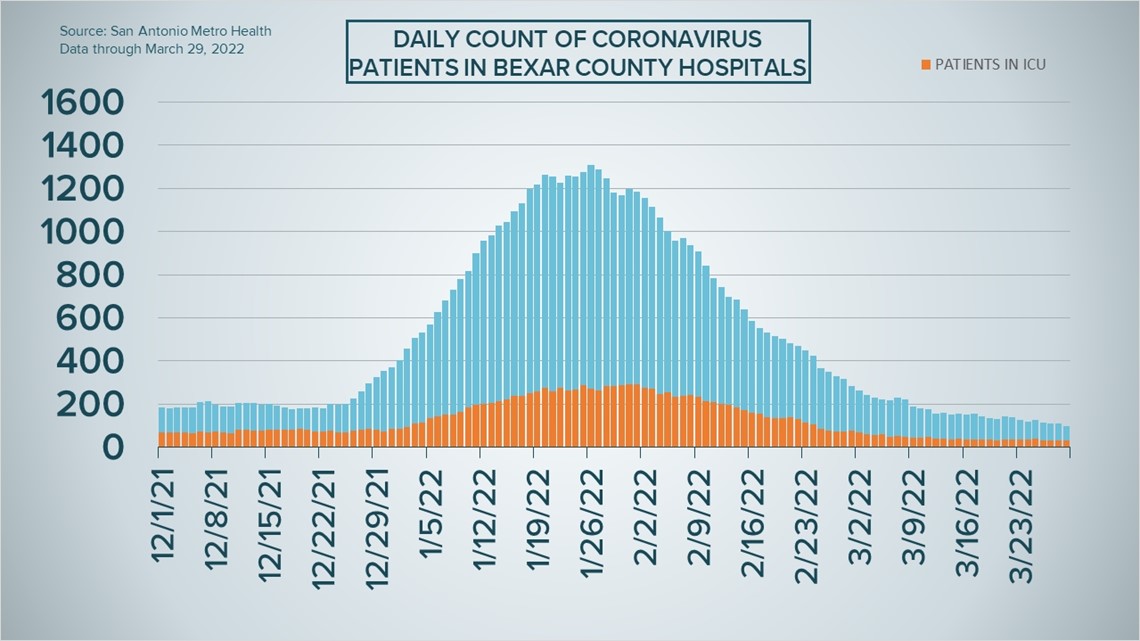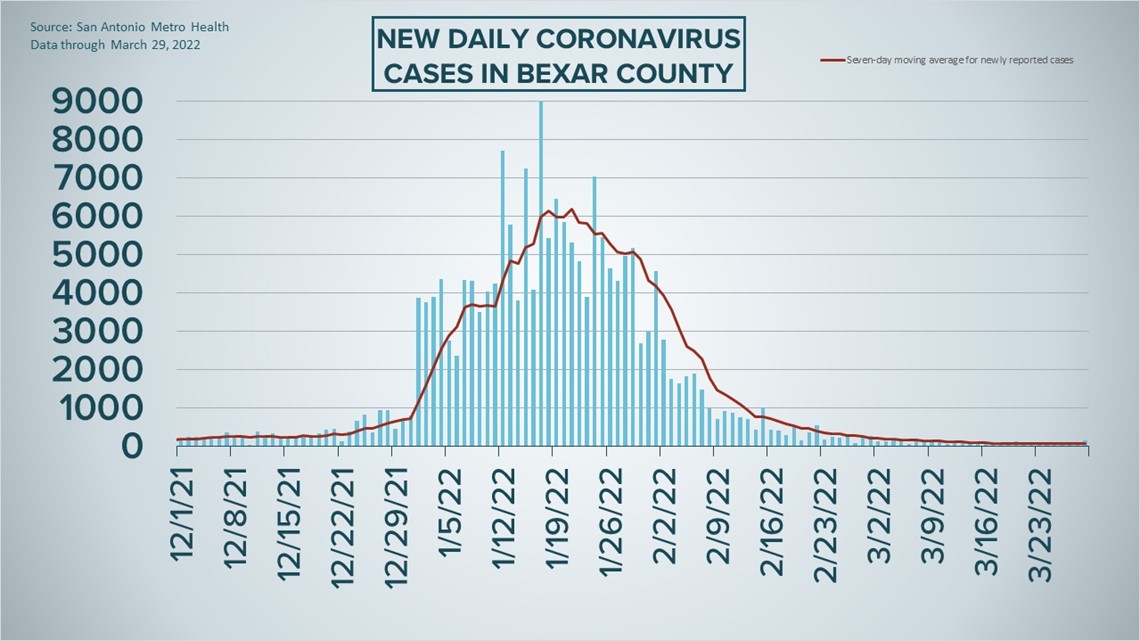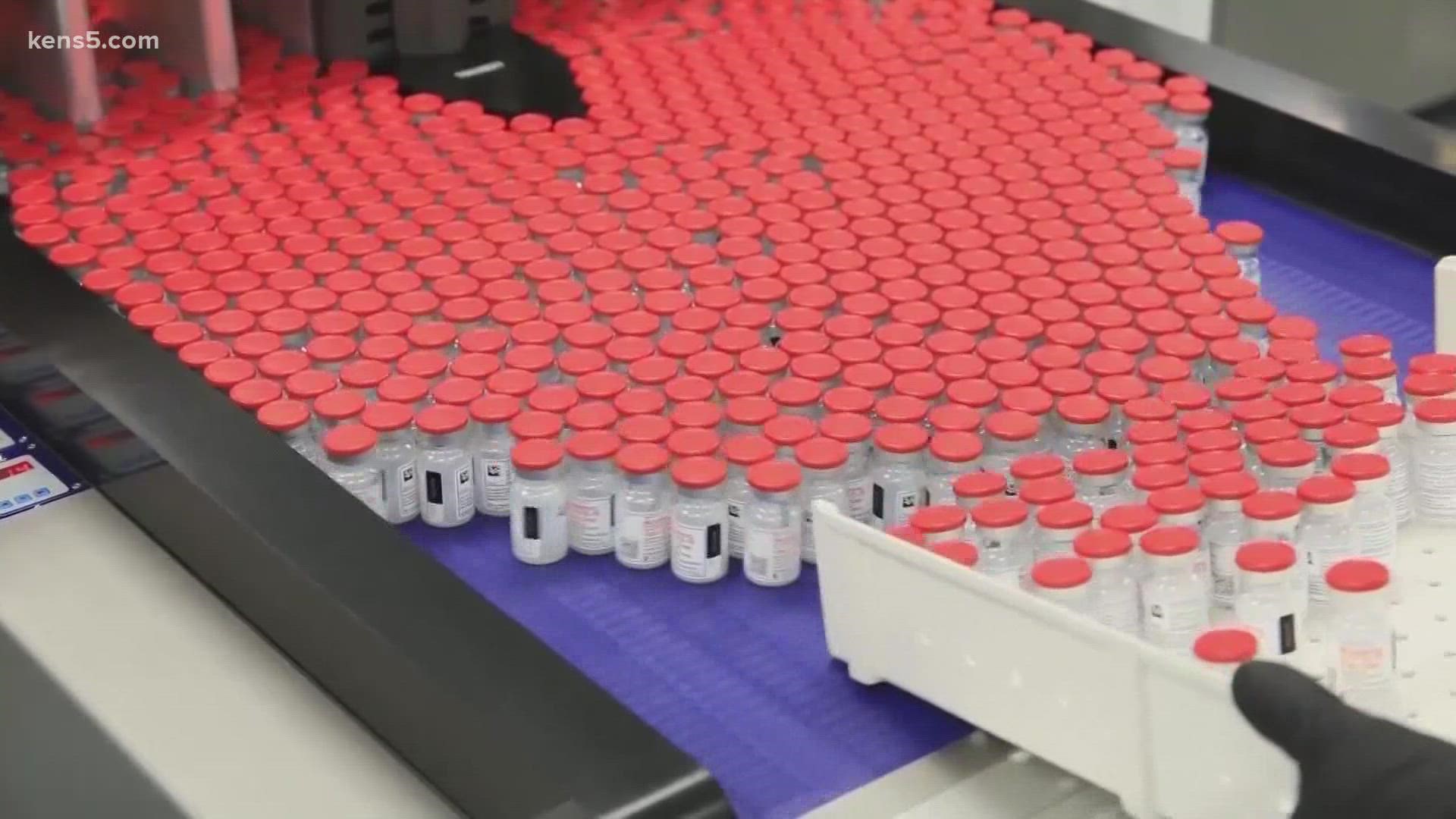SAN ANTONIO — While the medical community braces for a potential spring surge in COVID-19 cases, Bexar County's hospitalization numbers have fallen to double-digits for the first time since early June of the pandemic's first summer.
There were 98 patients battling COVID-19 symptoms in San Antonio-area hospitals Tuesday; June 8, 2020 was the last time the number was below 100. Hospitalizations are down by 29% since last Tuesday, and by 69% since the end of February. Of those 98 patients, 30 are in intensive care and 14 are on ventilators.
Daily case counts have also continued to trend down this month, although Tuesday proved somewhat of an exception: For only the second time in the last two weeks, and for the tenth time in March, Metro Health recorded more than 100 new infections, with a total of 151. It's still a microscopic number compared to the nearly 4,800 new diagnoses the community saw on an average day in January, but it brings the seven-day case average up to 74 from 56, where it stood on Monday.
Meanwhile, the omicron variant which has rapidly spread across China and Europe in recent days has been detected in Bexar County, which is why health authorities continue encouraging the community to get up to date on vaccinations (a list of pop-up clinics can be found here). According to the Centers for Disease Control, the BA.2 variant amounted to 55% of last week's new infections; Metro Health officials tell KENS 5 it "expects similar trends locally."
One additional virus-related death was recorded by health authorities on Tuesday, bringing Bexar County's pandemic death toll to 5,311. More than 533,000 residents have been diagnosed with COVID-19.
How Bexar County is trending




Vaccine Progress in Bexar County
The following numbers are provided by San Antonio Metro Health. A full breakdown can be found here.
- 1.432 million eligible Bexar County residents are fully vaccinated as of Monday, March 21.
- More than 490,000 eligible Bexar County residents have received their COVID-19 booster shot, as of Monday, March 21.
The CDC states that "when a high percentage of the community is immune to a disease (through vaccination and/or prior illness)," that community will have reached herd immunity, "making the spread of this disease from person to person unlikely."
The City of San Antonio breaks down the vaccination rates by zip code on Metro Health's Vaccination Statistics page.
Coronavirus in Texas
The total number of coronavirus cases in the state since the pandemic began grew by 3,253 on Tuesday, according to the Texas Department of State Health Services. That total includes 1,465 new confirmed cases and 1,788 new probable cases. More details can be found on this page.
Tuesday's figures bring the total number of Texans diagnosed with COVID-19 to more than 6.66 million.
An additional 35 Texans have died from virus complications, meanwhile, raising the statewide death toll to 85,903.
Coronavirus symptoms
The symptoms of coronavirus can be similar to the flu or a bad cold. Symptoms include fever or chills, cough, shortness of breath or difficulty breathing, fatigue, muscle or body aches, headache, new loss of taste or smell sore throat, congestion or runny nose, nausea or vomiting, and diarrhea, according to the Centers for Disease Control.
Most healthy people will have mild symptoms. A study of more than 72,000 patients by the Centers for Disease Control in China showed 80 percent of the cases there were mild.
But infections can cause pneumonia, severe acute respiratory syndrome, kidney failure, and even death, according to the World Health Organization. Older people with underlying health conditions are most at risk.
Experts determined there was consistent evidence these conditions increase a person's risk, regardless of age:
- Chronic kidney disease
- COPD (chronic obstructive pulmonary disease)
- Obesity (BMI of 30 or higher)
- Immunocompromised state (weakened immune system) from solid organ transplant
- Serious heart conditions, such as heart failure, coronary artery disease, or cardiomyopathies
- Sickle cell disease
- Type 2 diabetes
- The CDC believes symptoms may appear anywhere from two to 14 days after being exposed.
Human coronaviruses are usually spread...
- Between people who are in close contact with one another (within about 6 feet).
- Through respiratory droplets produced when an infected person coughs, sneezes or talks. These droplets can land in the mouths or noses of people who are nearby or possibly be inhaled into the lungs.
- Some recent studies have suggested that COVID-19 may be spread by people who are not showing symptoms.
Help stop the spread of coronavirus
- Stay home when you are sick.
- Eat and sleep separately from your family members
- Use different utensils and dishes
- Cover your cough or sneeze with your arm, not your hand.
- If you use a tissue, throw it in the trash.
Find a Testing Location
City officials recommend getting a COVID-19 test if you experience fever or chills, cough, shortness of breath or difficulty breathing, fatigue, muscle or body aches, headache, new loss of taste or smell, sore throat, congestion or runny nose, nausea or vomiting, or diarrhea.
Here's a Testing Sites Locator to help you find the testing location closest to you in San Antonio.
Latest Coronavirus Headlines
- No, ‘deltacron’ and the BA.2 subvariant of COVID-19 are not the same
- FDA authorizes another booster of COVID vaccine for people 50 and up
- Shanghai lockdown tests 'zero-COVID' limits, shakes markets
- Biden spokesperson tests positive for COVID-19 after Europe trip
- Experts worry about how US will see next COVID surge coming
- Bus brigade in Laredo is vaccinating Mexican citizens with COVID-19 shots that Texans aren’t using

